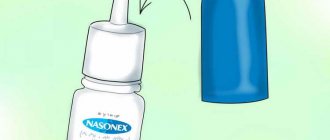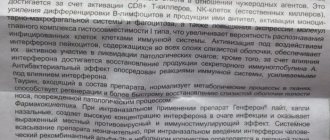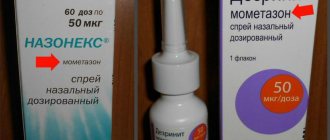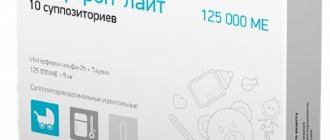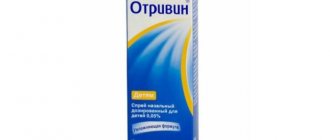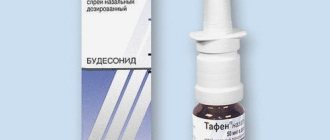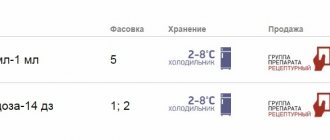Pharmacological properties of the drug Avamis™
Pharmacodynamics. Fluticasone furoate is a synthetic fluorinated corticosteroid with a very high level of affinity for glucocorticoid receptors and a strong anti-inflammatory effect. Pharmacokinetics. Fluticasone furoate undergoes extensive first-pass metabolism and incomplete absorption in the liver and intestines, resulting in very little systemic exposure to the drug. Typically, with intranasal administration of 110 mcg 1 time per day, a plasma concentration of the drug is reached that cannot be measured (≤10 pg/ml). The absolute bioavailability of fluticasone furoate when administered 880 mcg 3 times a day (total daily dose - 2640 mcg) is 0.5%. The level of binding of fluticasone furoate to plasma proteins is 99%. The drug is widely distributed, with an average volume of distribution of 608 L. Fluticasone furoate is rapidly eliminated (total plasma clearance 58 L/h) from the systemic circulation, mainly by hepatic metabolism with the participation of the cytochrome P450 enzyme CYP 3A4 to an inactive carboxyl metabolite (GW694301X). The main mechanism of metabolism is the hydrolysis of S-fluoromethylcarbothionate to the metabolite 17β-carboxylic acid. It is excreted after oral and intravenous administration, mainly in feces with signs of excretion of fluticasone furoate and its metabolites in bile. After intravenous administration, the half-life is 15.1 hours. Urinary excretion is approximately 1% and 2% after oral and intravenous administration, respectively.
Which is better for a child: Avamis or Nasonex
This question was asked to specialists separately, as it interests many parents. The summary of the survey is as follows:
- both drugs contain synthetic glucocorticosteroids as the main substance;
- they are different in chemical structure, but the same in action;
- the scheme of their use is the same;
- Nasonex's list of side effects is longer;
- It also has more contraindications, but the main thing, like Avamis, is intolerance to the components.
Therefore, it will be better for the child to take a medicine that does not cause side effects and does not cause allergies.
Use of the drug Avamys™
Avamis is used only intranasally. Adults and children over 12 years of age: the recommended initial dose is 2 injections (27.5 mcg per 1 injection) into each nostril once a day (total daily dose - 110 mcg). After control of rhinitis symptoms is achieved, the maintenance dose of the drug can be reduced to 1 injection into each nasal passage once a day (total daily dose - 55 mcg). Children aged 6–11 years: the recommended initial dose is 1 injection into each nasal passage 1 time per day (total daily dose - 55 mcg). In case of insufficient control of rhinitis symptoms with injection into each nasal passage 1 time per day (total daily dose - 55 mcg), the dose can be increased to 2 injections into each nasal passage 1 time per day (total daily dose - 110 mcg). After control of rhinitis symptoms is achieved, the dose is reduced to 1 injection into each nasal passage once a day (total daily dose - 55 mcg). In elderly patients, the same doses are used as in adults. In case of renal failure, no dose adjustment is necessary. Mild to moderate liver failure There are no data regarding severe liver failure. To achieve the full therapeutic effect, the drug must be used regularly, which should be advised to the patient. The onset of action is observed 8 hours after the first use, the maximum therapeutic effect occurs a few days after the start of treatment. The duration of treatment should be limited to the period of influence of the allergen. Rules for using nasal spray Nasal metered spray consists of a glass bottle placed in a plastic case with a protective cap that covers the tip of the sprayer (a special device at the upper end of the spray). At the bottom of the body there are small holes through which the presence of the drug in the glass bottle can be seen. On one of the sides of the plastic body there is a large dispensing button, when pressed, the spray is supplied through the spray nozzle. Before the first use (and if the drug has not been used for 1 month), you should check the device:
- shake the closed bottle (without removing the protective cap);
- remove the cap by pulling it up, pressing lightly with your fingers on both sides;
- press the dispensing button firmly (at least 6 times) to release a sufficient amount of spray into the air.
Before each use, clean the nasal passages, shake the spray slightly and perform the following steps:
- tilt your head slightly forward;
- holding the spray vertically, carefully place the sprayer in one nasal passage;
- point the tip of the sprayer in the opposite direction from the bridge of the nose so that the medicine is evenly distributed in the nasal cavity;
- inhale through your nose and simultaneously press the dosing button on the plastic body to spray the spray into the nasal cavity;
- Avoid contact of the spray with the eyes; if this happens, rinse your eyes with water;
- Remove the spray tip from your nose and exhale through your mouth.
To administer the spray into the other nasal passage, repeat the procedure in the same sequence. Always close the device with the protective cap after use. After each use, wipe the spray tip and protective cap with a clean, dry cloth.
Analogs
There are no local nasal medications with a similar active ingredient. But sprays with another synthetic hormone are produced, the effect of which is similar to Avamis. These are Metaspray, Nasonex, Desrinit, also approved for use from 2 years of age, and from 12 years of age used for polyposis of the nasal passages, sinusitis, and for the prevention of allergic rhinitis. Nasobek, in contrast, is prescribed to children from the age of 6 and is used 2-4 times a day.
Side effects of Avamis™
Very often (≥1/10), often (≥1/100 and ≤1/10), rarely (≥1/1000 and ≤1/100), sometimes (≥1/10,000 and ≤1/1000), isolated cases (≤1/10,000). From the respiratory system: very often - nosebleeds; often - ulcers on the nasal mucosa. Nosebleeds were usually mild to moderate. In adults and adolescents, nosebleeds occurred more frequently with prolonged use (6 weeks) than with use up to 6 weeks. In pediatric clinical studies of up to 12 weeks, the incidence of epistaxis was similar between the fluticasone furoate group and the placebo group. From the immune system: sometimes - hypersensitivity reactions, including anaphylaxis, angioedema, rash and urticaria.
Indications
The main indications for the use of Avamis in the instructions for use are seasonal and year-round allergic rhinitis, although in practice many pediatric ENT doctors also use it in the complex treatment of sinusitis of any localization and hyperplasia of the lymphoid tissue of the nasopharynx (adenoids).
According to reviews of otolaryngologists who used Avamis in the conservative treatment of adenoids in children, the drug has an effective therapeutic effect and allows one to avoid surgical intervention.
Special instructions for the use of Avamis™
Fluticasone furoate undergoes extensive first-pass metabolism in the liver, therefore the systemic exposure of intranasal fluticasone furoate may be increased in severe hepatic impairment, which in turn may increase the risk of systemic side effects. Therefore, the drug should be used with caution in severe liver failure. It is not recommended to use the drug in combination with ritonavir due to an increased risk of systemic effects of fluticasone furoate. Exceeding the recommended dose of intranasal corticosteroids may cause clinically significant adrenal suppression. During periods of stress or planned surgical intervention, the need for additional use of systemic corticosteroids is taken into account if there are signs of exceeding the recommended dose of corticosteroids. The use of 110 mcg/day of fluticasone furoate is not associated with depression of the hypothalamic-pituitary-adrenal axis in adults and children. However, the dose of intranasal fluticasone furoate is reduced to the minimum effective. As with the use of other intranasal corticosteroids, in the case of concomitant use of any other types of corticosteroid therapy, their overall systemic effect is taken into account. When treating children with intranasal corticosteroids in recommended doses, cases of growth retardation were observed. Therefore, it is recommended to regularly measure the height of children during long-term therapy with intranasal corticosteroids. If the child's growth is delayed, therapy should be reconsidered in order to reduce the dose, if possible - to the minimum effective. If signs of suppression of adrenal function occur, the patient should be transferred from systemic steroid use to intranasal fluticasone furoate with caution. Avamys contains benzalkonium chloride, which may cause irritation to the nasal mucosa. During pregnancy and breastfeeding. Fluticasone furoate is used during this period if the expected benefit to the mother outweighs the possible risk to the fetus/child. in children under 6 years of age, since there is insufficient experience with the drug in pediatric practice. The ability to influence reaction speed when driving vehicles or operating machinery is unlikely.
Immune and nervous systems, organs of vision
Hypersensitivity is rarely observed - urticaria, Quincke's edema, anaphylactic shock, rash from Avamis. Side effects of Avamis include frequent pain in the head area. The use of glucocorticosteroids contributes to a number of psychological effects and behavioral disorders. This also includes psychomotor hyperactivity, sleep disturbance, depressive states, aggression, and internal anxiety. Different patients have different manifestations.
Patients complain that headaches begin as a side effect of the medication. In fact, there are a huge number of causes for this pathology. We talk about viral infections, hypertension, allergic reactions. In women, nausea and headaches are associated with menstruation.
These conditions are accompanied by stress and serious mental tension. The same signs are possible in the presence of a brain tumor and disturbances in the functioning of blood vessels. Some women notice a delay in their periods from Avamis.
Transient disturbances in vision may occur, but the frequency is unknown. The doctor must be vigilant regarding various systemic phenomena. We are also talking about changes in the organs of vision.
If vision deterioration or increased intraocular pressure, cataracts, or glaucoma are observed, serious monitoring is required. Sometimes a cough is noted after taking Avamys. In such a situation, it is advisable to abandon the medication and not aggravate the situation. The doctor will prescribe another remedy for therapy.
Interactions of the drug Avamys™
Fluticasone furoate is rapidly eliminated by extensive first-pass metabolism in the liver via cytochrome P450 3A4. According to the results of the use of another GCS - fluticasone propionate, which is also metabolized by CYP 3A4, its combined use with ritonavir is not recommended due to the increased systemic effect of fluticasone furoate. Fluticasone furoate should be used with caution in combination with strong CYP3A4 inhibitors due to increased systemic exposure to fluticasone furoate. In a clinical study of the drug interaction of fluticasone furoate with the strong CYP3A4 inhibitor ketoconazole, the number of subjects with measurable plasma concentrations of fluticasone furoate was greater in the ketoconazole group (6 in 20) compared with the placebo group (1 in 20). This slight increase in systemic exposure did not cause a statistically significant difference in 24-hour plasma cortisol levels in the 2 groups. Data from enzyme induction and inhibition studies suggest that there is no reason to expect a metabolic interaction between fluticasone furoate and other mediators of cytochrome P450 metabolism at appropriate intranasal doses for clinical use. Therefore, clinical studies have not been conducted to study the interaction of fluticasone furoate and other drugs.
Reviews
The opinion of parents is not always objective: they may not take into account the effect on the child’s condition of other drugs used in complex therapy. In this case, all the “bumps” fall on the head of the new, especially hormonal, remedy. Therefore, it is better to find out reviews from various qualified specialists to get an idea about Avamis.
- ENT doctor with 3 years of experience: I use the spray to treat both allergic rhinitis and sinusitis and nasal polyposis, it copes with the task perfectly, no bleeding has ever been observed.
- Allergist with 6 years of experience: I often prescribe it to children as young as 2 years of age; some have experienced side effects in the form of rare nosebleeds.
- Pediatric surgeon with 13 years of experience: the antiallergic effect occurs within the first day of use, it should be used only as prescribed by a pediatrician or allergist, the only drawback is the high price.
- Allergist with 8 years of experience: has a powerful anti-inflammatory effect, does not cause side effects when used correctly, and the price is reasonable.
- ENT with 5 years of experience: fast onset of effect, many doses in one bottle, side effects are rare (dry nasal mucosa, bleeding), but medical supervision is necessary.
Contraindications
In case of hypersensitivity or individual intolerance to fluticasone furoate or any other component of the composition indicated in the annotation to the instructions, Avamis should not be used. Do not prescribe hormonal sprays and drops for a runny nose in children under 2 years of age.
Among the general contraindications to the use of hormonal drugs are:
- herpes viruses, especially type 4, which causes mononucleosis;
- respiratory tuberculosis;
- recent therapy with Ritonavir (in patients with HIV infection);
- surgical interventions on the nasopharynx.
These conditions severely suppress the immune system. Corticosteroids have immunosuppressive properties, which are the key to treating true allergies. But increasing this load on the body has a negative impact on health.
Is it possible to have Avamis at a fever? There is no reliable data on the effect of the drug in hyperthermia. In order to reduce fever, hormonal intranasal sprays are not used.
Overdose
Clinical observations were based on the development and severity of systemic side effects. A dose for adults exceeded 24 times the recommended dose, daily for three days or longer, did not affect the development of unwanted reactions in the body.
How many days in a row can I use Avamys? The course of therapy is determined by the doctor. The purpose of glucocorticoid treatment is important. In complex therapy of ENT diseases, sometimes 2-3 days of using the drug are enough. To eliminate the symptoms of allergic rhinitis, you need to use Avamis for at least 14-30 days without interruption.
There are no known cases of acute overdose. If you suspect that the recommended concentrations of intranasal corticosteroids are exceeded, their administration should be discontinued. Treatment in this case is symptomatic.
Can Avamys be used frequently? Yes, the drug is designed for regular use over a long period of time. Clinical studies have proven its tolerability and safety. But if acute symptoms of rhinitis appear for too long, more than 3-4 months, you need to consult your doctor again.

